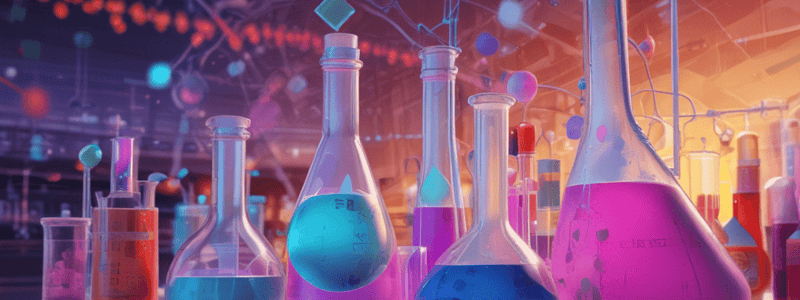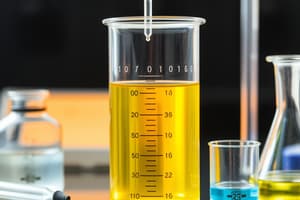Podcast
Questions and Answers
The number of moles of NaOH needed to neutralize 1 mole of H2SO4 is 1 mole.
The number of moles of NaOH needed to neutralize 1 mole of H2SO4 is 1 mole.
True (A)
In a strong acid-strong base titration, the pH of the resulting solution is always 7.
In a strong acid-strong base titration, the pH of the resulting solution is always 7.
True (A)
Washing the burette with distilled water, then with a little amount of the acid and then filling with the acid can lead to an error in titration.
Washing the burette with distilled water, then with a little amount of the acid and then filling with the acid can lead to an error in titration.
False (B)
Molality is a unit of concentration that is defined as the number of moles of solute per kilogram of solvent.
Molality is a unit of concentration that is defined as the number of moles of solute per kilogram of solvent.
A pH of 7.41 indicates a basic solution.
A pH of 7.41 indicates a basic solution.
A pipette is a less accurate apparatus than a burette.
A pipette is a less accurate apparatus than a burette.
The pH of a solution can be determined by titrating it with a strong acid or base.
The pH of a solution can be determined by titrating it with a strong acid or base.
The normality of a sulphuric acid solution is twice its molarity.
The normality of a sulphuric acid solution is twice its molarity.
Oxalic acid can be used as a primary standard in titration.
Oxalic acid can be used as a primary standard in titration.
Potassium permanganate is a strong oxidizing agent.
Potassium permanganate is a strong oxidizing agent.
Study Notes
Visual Detection of End Point
- End point can be determined by measuring potential with an indicator electrode relative to a reference and plotting against the volume of titrant.
- Three methods for visual detection:
- Self indication
- Starch detection
- Redox indicators
Self Indication
- If the reducing or oxidizing agent is colored, the end point can be detected by the appearance or disappearance of the color of the reagent.
- Example: KMnO4, where the end point can be detected by the pink color of permanganate.
Starch Indicator
- Used for titrations involving iodine.
- Starch forms a dark blue color with iodine (I2).
- Not a redox indicator, responds specifically to the presence of I2, not to a change in redox potential.
- Active fraction of starch is amylose, a polymer of the sugar α-d-glucose.
- In the presence of starch, iodine forms I6 chains inside the amylose helix and the color turns dark blue.
Redox Indicators
- Highly colored dyes that are weak reducing or oxidizing agents.
- Can be oxidized or reduced, and the color of both forms are different.
- Examples:
- Ferroin [tris(1,10-phenanthroline)iron(II) sulphate] for cerium(IV) titrations.
- Diphenylaminesulphonic acid for titrations with dichromate in acid solution.
Titrations with Oxidizing Agents
Potassium Permanganate
- A widely used oxidizing agent (E°= 1.51V).
- Can act as a self-indicator.
- Standardized by titration with primary standard sodium oxalate.
- Reaction: 5H2C2O4 + 2MnO4- + 6H+ → 10CO2 + 2Mn2+ + 8H2O.
- The solution must be heated for rapid reaction, catalyzed by the Mn2+ product.
- Permanganate titration not possible in the presence of chloride because it will be oxidized to chlorine.
Properties of Potassium Permanganate
- Strong oxidant with an intense violet color.
- Not a primary standard.
- Standard solution and stability:
- Aqueous solutions of KMnO4- are not entirely stable because they tend to oxidize water.
- Decomposition reaction is catalyzed by light, heat, acids, and manganese dioxide.
- Should be stored in dark glass bottles and kept away from high temperatures.
Standardization of Potassium Permanganate
- Not a primary standard.
- Standardized using oxalic acid: 2MnO4- + 5H2C2O4 + 16H+ → 2Mn2+ + 10CO2 + 8H2O.
Conditions for Potassium Permanganate Titrations
- Titration is carried out in acidic solution (1 M H2SO4), not HCl because permanganate titration is not possible in the presence of chloride.
- Titration is carried out at 70°C to expel CO2 and to catalyze the reaction, and to avoid the precipitation of MnO2.
Potassium Dichromate
- A slightly weaker oxidizing agent than potassium permanganate.
- Main advantage is its availability as a primary standard material.
- Does not react with HCl, so titrations can be performed in HCl medium.
- Reaction: Cr2O72- + 14H+ + 6e- → 2Cr3+ + 7H2O.
- The orange color of dichromate is not intense enough to be used to determine the end point, so external indicators should be used.
Cerium (IV)
- A powerful oxidizing agent.
- Its potential depends on the acid in which the reaction takes place.
- Can be used in the same titrations as permanganate, but the oxidation of chloride is slow.
- The salt of cerium, ammonium hexanitrocerate, is a primary standard material.
- Ferroin is a suitable indicator for such titrations.
Iodimetry
- Iodine is a moderately strong oxidizing agent that can be used to titrate reducing agents.
- Titrations with iodine are called iodimetric titrations.
- Reactions are performed in neutral or mildly alkaline pH (around 8) to weakly acid solutions.
- If the pH is too alkaline, I2 will disproportionate to hypoiodate and iodide.
- In acidic medium, starch is hydrolyzed, and the oxidizing power of iodine will also decrease.
Iodimetry (continued)
- Because I2 is not a strong oxidizing agent, this limits the number of reducing agents that can be titrated against iodine, increasing its selectivity.
- Pure iodine can be obtained by sublimation, but its solution should be standardized using As2O3.
- Iodine has a low solubility in water, but the complex I3- is very soluble.
- Iodine solutions are prepared by dissolving iodine in concentrated solutions of potassium iodide.
Iodometry
- Iodide ion is a weak reducing agent and will reduce strong oxidizing agents.
- It is not used as a titrant mainly because of the lack of a convenient visual indicator system, as well as the low speed of the reaction.
- When an excess of iodide (I-) is added to a solution of an oxidizing agent, I2 is produced in an amount equivalent to the oxidizing agent present.
- This I2 can be titrated with reducing agents, and the result will be the same as if the oxidizing agent was titrated directly.
- The titrating agent is sodium thiosulphate.
- This method is called the Iodometric method.
Iodometry (continued)
- Consider the determination of dichromate: Cr2O72- + 6I- + 14H+ → 2Cr3+ + 3I2 + 7H2O.
- I2 + 2S2O32- → 2I- + S4O62-.
- Each Cr2O72- produces 3I2, which in turn react with 6S2O32-.
- Thus, 6 millimoles of S2O32- are equivalent to Cr2O72-.
Notice
- We can't titrate strong oxidizing agents directly with thiosulphate because it might be oxidized to higher states such as sulphate (SO42-) rather than tetrathionate (S4O62-).
- Starch, used to detect the end point, should not be added from the beginning of the titration but near the end of the titration where the color of iodine is pale yellow, for two main reasons:
- Iodine starch complex is only slowly dissociated and diffuse end point would result in a large amount of iodine is adsorbed on starch.
- Base + salt → water + acid, and the reverse reaction.
Studying That Suits You
Use AI to generate personalized quizzes and flashcards to suit your learning preferences.
Related Documents
Description
This lecture covers the visual detection of end points in volumetric analysis, including self-indication and indicator methods. Prepared by Dr. Ahmed Bahgat.




